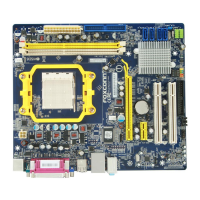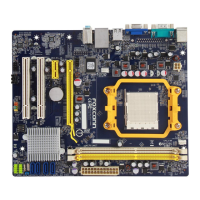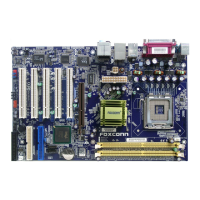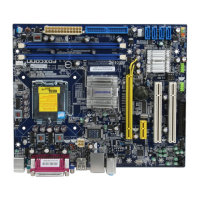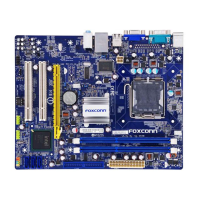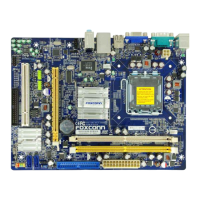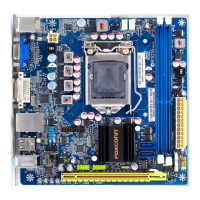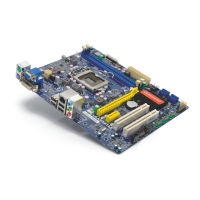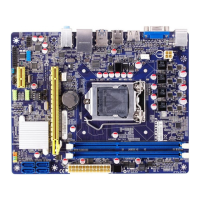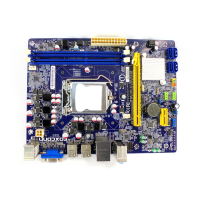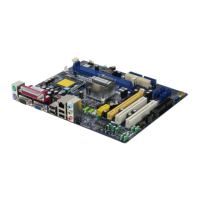
Do you have a question about the Foxconn M7VMX series and is the answer not in the manual?
| Model | M7VMX Series |
|---|---|
| Memory Type | DDR2 |
| SATA | 4 x SATA 3Gb/s |
| IDE | 1 x ATA133 |
| Audio | Realtek ALC662 6-Channel HD Audio |
| Form Factor | Micro ATX |
| CPU Socket | AM2 |
| Supported Processors | AMD Athlon, Sempron |
| Expansion Slots | 1 x PCIe x16, 1 x PCIe x1, 2 x PCI |
| LAN | Realtek RTL8201CL 10/100M LAN |
Details the technical specifications and components of the motherboard.
Illustrates the physical layout and location of motherboard connectors and components.
Describes the ports and connectors available on the motherboard's rear panel.
Step-by-step guide for installing the CPU and its cooler onto the motherboard.
Instructions for correctly installing memory modules into the DIMM slots.
Guide on how to install expansion cards into the available slots.
Details on connecting internal power supplies and other onboard headers.
Explains the function and configuration of various motherboard jumpers, including Clear CMOS.
Procedure to access the BIOS setup utility during system startup.
Overview of the BIOS main menu options and navigation controls.
Displays basic system configuration details like BIOS ID, date, time, and memory.
Accesses proprietary features for system control, such as overclocking and fan settings.
Allows manual adjustment of CPU and memory voltages for performance tuning.
Options for managing CPU features like thermal protection, EIST, and C1E.
Settings for boot device priority, security options, and startup behavior.
Configuration options related to the motherboard's chipset and graphics memory allocation.
Settings for enabling or disabling onboard devices like IDE, SATA, and USB controllers.
Configures the operating mode for SATA ports (IDE, AHCI, RAID).
Controls for onboard audio, LAN, and LAN boot ROM functionality.
Configuration for serial ports, infrared chips, and parallel ports.
Settings for USB operation mode, keyboard, mouse, and storage support.
Configuration of ACPI features for system power saving and wake-up events.
Monitors system temperatures, voltages, fan speeds, and sets shutdown limits.
Resets BIOS settings to factory defaults for troubleshooting or optimal performance.
Establishes a supervisor password to protect BIOS settings and system startup.
Sets a user password to restrict access to system startup or BIOS settings.
Saves current BIOS configuration changes and exits the setup utility.
Exits the BIOS setup utility without applying any configuration changes.
Lists the drivers and software utilities available on the included motherboard CD.
Guides the user through the process of installing essential drivers and software utilities.
Utility for monitoring hardware status and adjusting system performance settings.
Tool for backing up, updating, and managing system BIOS, drivers, and utilities.
Utility to backup, change, or delete the boot time logo displayed during POST.
Desktop Management Interface viewer for system hardware analysis and troubleshooting.
Explains the fundamental concepts and benefits of RAID technology.
Instructions for installing the NVIDIA driver to enable RAID functionality.
Step-by-step guide to creating a RAID 0 (Striped) array for performance.
Step-by-step guide to creating a RAID 1 (Mirrored) array for data redundancy.
Instructions for configuring a RAID 0+1 (Striped Mirror) array for speed and redundancy.
Guide on setting up a RAID 5 array for performance and fault tolerance.
Procedure for creating a Spanned (JBOD) RAID array for increased storage capacity.
Steps to install Windows XP on a newly configured RAID array.
Guide to setting up a RAID array for data storage on an existing system.

